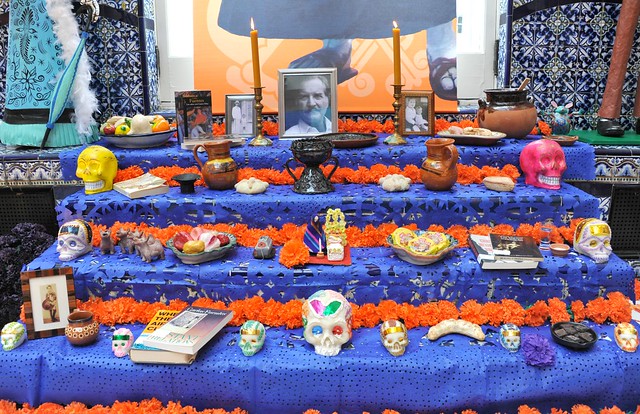Student’s learned a little bit about Three Kings’ Day, celebrated in
most Spanish-speaking countries (as well as other Catholic countries) on
January 6th. At then end of the presentation, students constructed
triangular prisms with the Reyes Magos
(Melchor, Gaspar, and Baltazar). Students will be bringing these home before
break. :)
Monday, December 22, 2014
Friday, December 19, 2014
Monday, November 17, 2014
Numbers in Spanish
We're starting to learn numbers in Spanish, working towards the goal of everyone being able to ask and answer the question "How old are you?" and "When is your birthday?" in Spanish.
Students who have taken Spanish before and already know the numbers by heart will be doing some slightly different tasks to keep them challenged.
Here's a great introductory video that teaches the numbers to 30.
And here is a fast, but fun video that counts to 50 in a song!
Students who have taken Spanish before and already know the numbers by heart will be doing some slightly different tasks to keep them challenged.
Here's a great introductory video that teaches the numbers to 30.
And here is a fast, but fun video that counts to 50 in a song!
Do you have a favorite youtube video with the numbers in Spanish? Check out what's available and post your favorite link below.
Alphabet Song!
We've been learning the letters of the alphabet in Spanish, and working a little bit on pronunciation (especially of vowels).
Here's the video we've been watching. In Chrome, you can click the "settings" button on the bottom right of the black screen around the video, and change the speed to 0.5 to hear it more slowly.
Here's the video we've been watching. In Chrome, you can click the "settings" button on the bottom right of the black screen around the video, and change the speed to 0.5 to hear it more slowly.
Friday, October 24, 2014
Día de los muertos
In class, we have started talking about Día de
los muertos, or Day of the Dead, as we learn about Mexican culture. This coming week we will be reading the book Pablo Remembers by George Anacona, which does a great job of telling the story of Day of the Dead through the perspective of a young boy in Mexico and includes lots of great Spanish vocabulary as it describes his family's preparation for the festival. Some key vocabulary words that students will be learning include:
Here are some great events going on in DC to celebrate Día de los muertos on November 1st and 2nd.
Calavera de azúcar, Pan de muerto, Papel Picado, Ofrenda, Flores,
Fotos, Velas
Here are some great events going on in DC to celebrate Día de los muertos on November 1st and 2nd.
1. Don't miss the Mexican Cultural Institute's annual Day of the Dead Altar on Saturday, November 1st! This well-known community event is a quintessentially Mexican tradition and one of our most colorful displays of the year. This year's Day of the Dead Altar is dedicated to the life and work of Latin American literary giant Gabriel García Márquez.
Born in Colombia on March 6, 1927, writer, journalist, and humanist Gabriel García Márquez died on April 17, 2014 in Mexico City, where he lived for most of the last 50 years. The Nobel-laureate, who epitomized the magical realistic writing movement, wrote some of his best-known works in Mexico, including One Hundred Years of Solitude.
The opening event will take place on Saturday, November 1st from 12 to 4 pm and will remain open to visitors and school groups until November 7th during regular hours.
More information about the Mexican Cultural Institute of DC here.
2. Celebrations, Demonstrations and hands-on activities begin at 10:30 am on Saturday, November 1st at the National Museum of the American Indian in DC. Events include demonstrations of barriletes gigantes (Guatemalan Kites), papel picado making demonstrations, and a book signing by author Sandra Cisneros on Sunday. More info about the celebration at the National Museum of the American Indian here.
Wednesday, October 1, 2014
By popular demand! Here are some of the videos we have been using in Spanish class since the beginning of the year:
Sunday, September 28, 2014
We have been working on learning the body parts for the past week.
If your student is eager to learn more Spanish vocabulary, this is a great video with a LOT of different vocabulary words related to the body.
If your student is eager to learn more Spanish vocabulary, this is a great video with a LOT of different vocabulary words related to the body.
Saturday, September 13, 2014
What we're working on!
This week, we are working on asking and answering basic questions in Spanish.
We are currently focused on:
We are currently focused on:
¿Cómo te llamas? What is your name?
Me llamo… My name is...
¿Cómo estás? How are you?
Estoy… (bien, muy bien, regular, así-así, mal, muy mal) I am...
Students are also learning some basic classroom commands in Spanish, and had a blast playing "Simon says" in Spanish earlier this week.
Friday, September 12, 2014
Subscribe to:
Comments (Atom)



